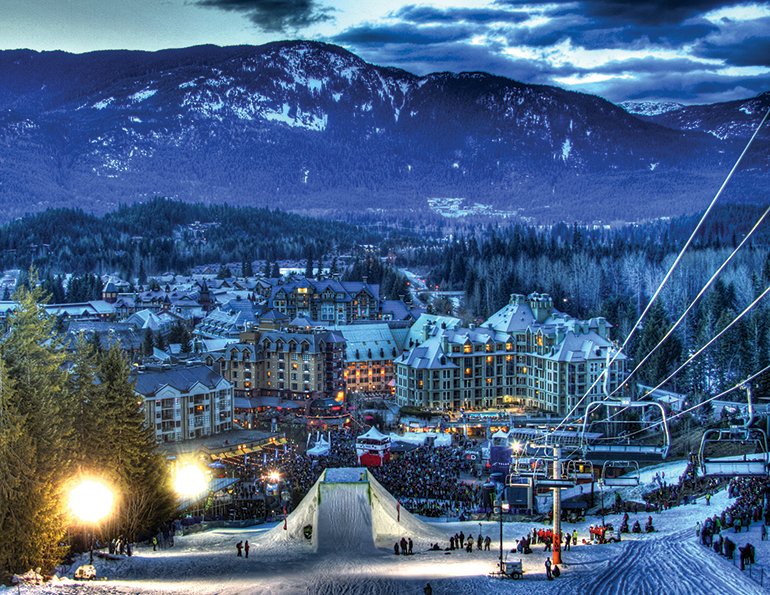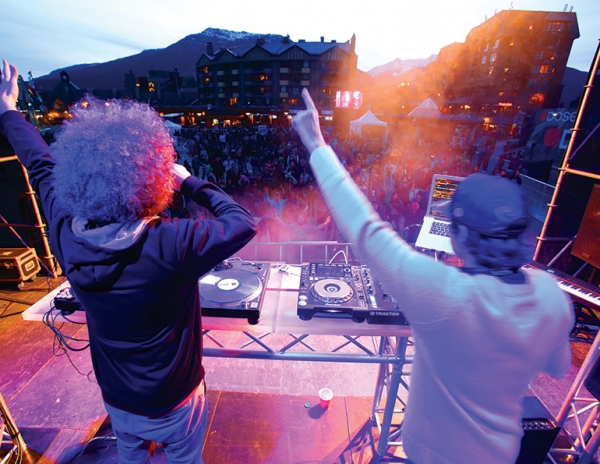If we could just stop here and agree to point the finger at Mother Nature, we could brush aside the tough questions. After all, whether you’re selling lift tickets or tee times, too little or too much precipitation can make mince meat of sales targets. We’ve seen the truth in that over the past four seasons. But is it really fair to blame 40 years of flat-lining on a few El Niño’s or La Niñas?
A closer look at some of the barriers—and the opportunities—to attracting new skiers and riders to the mountains, or even attracting those who already consider themselves to be one or the other, reveals plenty more to the story.
Lets start with numbers: 40 years ago, 12 million U.S. skiers racked up 53 million skier visits. Last season, 13 million skiers and riders totaled 53.6 million skier visits. As a percentage of the U.S. population, roughly 5.5 percent of people skied 40 years ago, while just four percent ski and/or ride today.
Don’t think that’s a big deal? Consider that in those 40 years an entirely new winter sport (snowboarding) secured its place on the hill, formerly hard-to-reach resorts began offering direct daily flights, grooming and lift services are miles better, and somewhere along the way, action sports went “mainstream.” And still, the number of skier days has remained flat.
Sure, with the right weather pattern, all ships rise. In the “epic” 2010-11 season, U.S. ski resorts logged a record 60.5 million visits. But were those just regular skiers and riders motivated by powder days to make more trips? Why have skier days not really grown while the number of participants has grown by one million? Why are fewer and fewer newcomers taking up skiing and snowboarding, despite the industry’s efforts to increase these numbers ?
“We have 10 million people who consider themselves skiers and riders that didn’t participate at all last year,” says Kelly Davis, director of research for Snowsports Industries America (SIA). Davis spearheaded SIA’s Downhill Consumer Intelligence Project (DCIP), which consisted of gathering data from the past 30-40 years, and surveying approximately 150,000 Americans about sports participation. The survey was conducted by the multi-sport Physical Activity Council.
“We asked those lapsed people why they haven’t participated, and the first answer is not enough time, the second is expense, and the third is that they don’t have anyone to go with,” Davis says.
ADDRESSING THE "WHYS"
Whether time is a bona fide reason depends on whom you talk to. A litany of generational marketing surveys tells us that consumers feel more time-poor every year, particularly Generation X adults and Millennials with kids.
The cost of skiing and riding is a more widespread concern that’s been a hurdle for decades, but there are disturbing trends of late. NSAA data shows that the industry has seen an increase in the number of resort visitors with a household income of more than $150,000, while the number of visitors who earn less than $150,000 annually is shrinking. Even the number of visitors who earn $100,000-$150,000 is shrinking. That may not come as a surprise, but it certainly limits the pool of potential visitors. Fifty-six percent of snow sports participants have a household income of more than $100,000, but only 22 percent of the U.S. population earns that much.
What if people simply decide winter sports aren’t worth it? Rob Linde, director of development for RRC Associates, is concerned after reviewing NSAA’s recent Millennial study. “I was interviewing a 27-year-old guy who told me he was into triathlons, and that skiing had gotten expensive, so he didn’t do it as much. Yet he was doing triathlons once a month and traveling to do them. This was a young, athletic guy who could afford to ski if that was his priority. I think he just chose to do something different, but packaged it in a way that he was saying skiing was too expensive.”
This reality illustrates the challenges the ski industry faces in positioning snow sports over other activities. “Resorts offer lots of great values and deals. What we need to do is invite people to experience them,” Linde says.
Those who already participate are taking full advantage. Season pass sales are at an all-time high. But that doesn’t help create new participants.
If time and money are legitimate reasons people don’t ski or ride, or they aren’t being made aware of improved value offerings, that’s one thing. If money and time are excuses people make because they choose to spend their money elsewhere, that’s another issue entirely.
THE CHANGING CULTURE
Of course, the winter sports industry is not the only active lifestyle pursuit facing growth issues. After growing by 50 percent from the mid 1980s until the turn of the century, golf participation has plateaued and is now declining. Tennis, many team sports, and other outdoor activities face flat or declining participation also. Even soccer participation was down four percent last year, according to Davis. “Everyone is trying to find a way to make sure they maintain who they have and are appealing to their target audience, and all are struggling with it,” she notes.
“We’re all trying to compete against screen time,” she explains. “We surveyed for 120 activities, and 80 million people say they don’t even get up off the couch and go for a walk.”
When it comes to kids, the task of prying them away from a stagnant lifestyle might be even more challenging when they become adults. A Kaiser Family Foundation study done in 2010 found that the average 8- to 10-year-old spends nearly eight hours each day with a variety media, while teenagers spend more than 11 hours per day engaged with some sort of screen. Davis wonders if the virtual world has become more appealing to them than the real world. How do you market to a teenager who would rather sit on the couch and play Tony Hawk’s Pro Skater 5 than, you know, actually go skateboarding?
A 2015 Leisure Trends LeisureTRAK Report on Outdoor Activity Participation also reveals the extent of the sedentary lifestyle. When asked if they had participated in any sport, recreational, or fitness activity in the last three months,
the percentage of those responding yes decreased from 55 percent to 50 percent from 2014 to 2015. Twenty years ago, this percentage was as high as 65 percent; it has ranged from 50 to 55 percent for much of the past decade. Screen time leapt in the early 2000s and has remained high, crowding out other activities.
Active vacations are also trending downward. The percentage of Americans who reported taking a sport, outdoor, or recreational vacation fell from 20 percent to 16 percent from 2014 to 2015.
MILLENNIAL CONUNDRUM
The one demographic that every industry is trying to reach is Millennials—roughly those born from the early 1980s to the early 2000s—and within that demographic, the 18-24 age group is the one whose winter sports participation has declined the most in recent years. The goal of keeping those individuals engaged in winter sports once they’ve grown out of family ski trips has proved challenging. According to SIA’s Downhill Consumer Intelligence Project, snowboard participation is down 23 percent since 2010-11 among this age group.
“One of the big findings [from NSAA’s Millennial study] is that these are not just changes within an age bracket, but societal changes—the way people behave and their patterns are different than a number of years ago,” says Linde. “If we don’t, as an industry, collectively look ahead, we’re going to be left behind as a sport.”
The recent Great Recession, Linde says, had a greater impact on Americans than those in the often-isolated world of snow sports might realize. “The value of money is going to be a bit different,” he says. “One thing that is affecting the Millennial population is college debt. They are graduating with enormous debt load, and it really changes people’s priorities.” Young adults today simply don’t have the money that previous generations had at this point in their lives. Decisions such as buying a home or a vehicle, or even getting married, are all being tabled due to their debt burden.
Millennials still ski and ride, but at about half the frequency of the Boomers. In order to maintain visitation numbers, the industry needs to recruit twice as many Millennial participants. “And that’s even true now,” Linde points out. “The frequency of skiing and riding is higher with the Boomer generation than with Millennials.” Think about that: skiers and riders 55 and older currently ski and ride more often 20-somethings.
SIA’s Davis says every industry that has produced a Millennials report tells a similar tale. “There are a lot of variables in that group, and we’ve seen attrition, especially in the last four or five years,” she says. “When you’ve got something like one in four males between the ages of 18 and 25 living at home, that’s not good, either. They can barely afford to eat out, so they aren’t traveling to ski.”
STRATEGIC PLANNING
Davis believes there’s not a lot of panic, yet, because overall participation is pretty stable. But is being stable good enough? And now that we have this research that hints at things to come, what do we do with it?
The first decision is whom to target with your resources. Is it more important to keep a 30-year-old casual snowboarder in the sport, or to attract a 12-year-old for the first time? The latter could be more valuable, but take more work.
Davis says many resorts have an in-depth understanding of their existing customer base—including what it is that they want and the experience they are having. In order to grow, however, it’s crucial to look further afield.
“You have to understand who your potential customer is, and where is your next customer coming from,” Davis says. “If you’re interested in growing your base, where should you target your marketing? Do you double down on core and go for reliable pass buyers, or do you try to find your next lifelong skier or rider? How do you find that customer and get them into snow sports and then get them to your resort?”
SIA’s DCIP went deep into demographic and psychographic trends. Davis finds the insights encouraging. “We can find newcomers among action sports participants ages 13 to 25. The reasons they don’t come are manageable. They don’t know how to get started, or have no one to come with. They are also concerned about climate change—will there be skiing in the future? Of course, we have explanations,” Davis says.
There are other hopeful signs. Each year, 13 million kids go sledding. The crossover to downhilling is only about 25 percent. “We can translate a group like that [into skiing] if we focus on it,” adds Davis.
Bringing skiing and riding to places where those individuals live, such as sledding hills in urban areas, could be a fruitful approach. “We can connect snow sports to other outdoor winter events and to snow play,” she says. “There are all kinds of places where we can introduce people.”
Resorts and suppliers can also use social media to drive those curious about winter sports to sites that educate them on skiing and snowboarding. “Get info to them the minute they show any interest,” Davis urges.
And don’t stop there. Connect people with transit, the sharing economy, and ways to get to the areas, such as uberSki in Salt Lake City. Connect, too, to trends like festivals and farm-to-table events, she adds.
MILLENNIAL MARKETING
Linde’s point on behavioral changes in society warrants examination. No group is changing the game like Millennials. A very social group, friendships are of utmost importance to them, and social events are a huge part of their lives.
“They will travel in groups differently than previous generations,” Linde says. “A decision to go skiing is made much closer to the time of departure. On Monday, Tuesday, or even Thursday, they may think about the weekend and then start texting or using a social platform to communicate with their group and make plans.”
For resort marketers, appealing to that impulsiveness is critical. “One person as an influencer is going to bring four or five other people along with them,” Linde says. “And we know that friends and families are what introduce new people to the sport. In our marketing, if we can harvest that approach and send out offers that appeal to the influencers, it will branch out to other people from them.”
Another key trend: more and more resort visitors—especially young ones—don’t visit ski towns to ski or ride. “It’s a different line of thinking,” Linde says. “The act of skiing may not be as important as it was to a Baby Boomer. It’s about going to the mountains. Being with your friends, sharing a condo together, drinking, and having fun is all part of that overall experience.”
The image of a guy ripping through waist-deep powder may not be what resonates with this broader audience, which has no clue how to ski powder or the feeling that avid skiers and riders associate with it. Instead, it might be more drawn to imagery of a group of people enjoying a social environment. And, in the end, isn’t that what most of us remember about a ski trip years later—the laughs shared over drinks, the conversations on the chair, and the new friends we make?
 South by Southwest, an annual set of film, media, and music festivals, drew more than 80,000—mainly Xers and Millennials—in 2015.Festivals like Coachella and South by Southwest have become favorites of Millennials and Gen Y, which is one reason snow-themed festivals like Whistler’s World Ski and Snowboard Festival and Park City’s Sundance Film Festival have been floated as a means for attracting the less hardcore crowd to mountain towns. From there, the conversion to skiing or snowboarding is a shorter walk, thus reducing a common barrier of entry.
South by Southwest, an annual set of film, media, and music festivals, drew more than 80,000—mainly Xers and Millennials—in 2015.Festivals like Coachella and South by Southwest have become favorites of Millennials and Gen Y, which is one reason snow-themed festivals like Whistler’s World Ski and Snowboard Festival and Park City’s Sundance Film Festival have been floated as a means for attracting the less hardcore crowd to mountain towns. From there, the conversion to skiing or snowboarding is a shorter walk, thus reducing a common barrier of entry.
Boston-area resident Robert Salley knows this first-hand. Growing up near Philadelphia, he didn’t ski. In his early 30s he spent five days in Park City during the Sundance Film Festival with a large group of friends. They were all skiers, so he bounced around town solo during the day, waiting for the rest of the guys to return from the slopes for happy hour. The next year, he decided to take snowboarding lessons in Park City, then made a point to take more back in New England.
“There’s no doubt I would not have taken up snowboarding if I hadn’t gone to Sundance,” he says. “It just wasn’t something I’d grown up around. But being in a mountain town and being around it all made me curious. Once I took a lesson and saw some improvement, I was hooked. And it allowed me to hang out with my friends all day, have some laughs on the chairlift and then tell stories about it later.”
Now 38 and the father of a three-year-old daughter, Salley plans to teach her to ski or ride in a year or two.
 The World Ski & Snowboard Festival, a 10-day annual celebration of snowsports, music, arts, and mountain life in Whistler, B.C., attracts more than 250,000 visitors. The folks at Whistler hope non-skiing attendees at the World Ski and Snowboard Festival in April make the same decision Salley did. The springtime bash pulls in a range of guests, from hardcore skiers and riders to hardcore partiers. As Lauren Everest, public relations and communications manager for Whistler Blackcomb, says, “The all-inclusive nature of the festival naturally attracts more than just skiers and snowboarders.”
The World Ski & Snowboard Festival, a 10-day annual celebration of snowsports, music, arts, and mountain life in Whistler, B.C., attracts more than 250,000 visitors. The folks at Whistler hope non-skiing attendees at the World Ski and Snowboard Festival in April make the same decision Salley did. The springtime bash pulls in a range of guests, from hardcore skiers and riders to hardcore partiers. As Lauren Everest, public relations and communications manager for Whistler Blackcomb, says, “The all-inclusive nature of the festival naturally attracts more than just skiers and snowboarders.”
To help convert the non-skiers, the resort leans on its robust data capture program to secure the names and contact info of the attendees so that it can send them offers for return/future visits.
Of course, growth doesn’t have to come from traditional places and large-scale festivals. Over the last decade, several resorts have begun to lure non-white ethnic groups to the mountains, with great success. (See related story, "Reaching New Markets, Part II".)
On a broad scale, the data from various industry-related surveys should confirm what most people already suspect, says Linde. But it should also trigger adaptation. “It’s not just recognizing Millennials and their behavior, but also that buying decisions are changing,” he says. “The competition is all those other things people can do with their time. And skiing ranks right up there with them all as far as the quality of the experience.”
ADOPTING NEW TACTICS
The winter sports industry is responding. As Linde points out, NSAA is leading that charge, and has been for a decade. He mentions Burton’s Learn to Ride program and Head’s commitment to attracting new skiers as two examples among many manufacturers that are innovating in an effort to grow winter sports. There have been changes in lifts (such as conveyors) and grooming, in processing people through rental shops and ticketing systems, and in terrain-based learning programs—all in an effort to make it easier for people to access the mountains and enjoy the experience of sliding on snow.
Davis points to the low hanging fruit of the broad, casual skiing and riding public. “Eighty percent of the market is made up of casual skiers and riders who go less than nine times per year,” she says. “Do we really understand them? Do we put ourselves in their shoes and understand what their experience is like?”
Alternatively, do the casual skiers and riders—and especially the never-beens—understand what the snow sports experience can be like? Those who immerse themselves in snow sports understand all the positives that come from it, but those benefits can be very difficult to convey to outsiders. People need to experience it for themselves in order to recognize that the benefits extend well beyond health and exercise, fresh air, love for travel, family time, or even developing the simple character trait of being able to handle a little bad weather without whining.
“It’s an interesting question about snow sports,” Davis says. “Because you can ski with someone for a day and be friends for life. That doesn’t happen when I go for a run with someone or if you go out drinking with your buddies. If we could get to the bottom of that, now that would be something.”
SAMMY GUEST EDITOR
Small community ski areas are crucial to the future of skiing and riding. I grew up skiing at Crotched Mountain and Pats Peak, N.H., and they converted a staggering number of school kids for life. I remember how much fun it was to ride the bus up to the mountain and play on snow with all my friends. Through this, I got hooked early in life. When it comes time for me to decide if I want some new clothes or a new pair of skis—well, just look at my wardrobe.
The Millennial challenge started when we all failed to convert their generation at ages 3 to 5. They did not grow up with skiing and riding as part of their winter life. If we are to convince them, or anyone, that their discretionary income is best spent on downhill adventures, we had better make skiing an important part of their life at a very early age.
At Mt. Ashland we are focused on increasing participation across the board, but have a real focus on our after-school programs. We recognize that the funnel is no longer full, so programs like we offer are crucial. Local mountains like ours can remove the barriers, such as cost, ease of use, and the time commitment. It is not unusual for our guests to come up and take a few runs, then be back down in the valley in time to put in a full day of work. Our ticket price is less than half the national average. Our three-day learn-to package costs only $124 for lifts, lessons, and rentals—and includes a free season pass and rentals for the rest of the season as a graduation present.
With the proper funnel-filling techniques, skiing and riding will have a secure place in American culture for a very long time. —Hiram Towle





